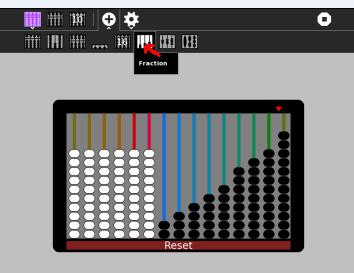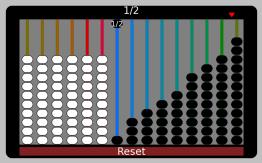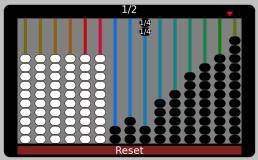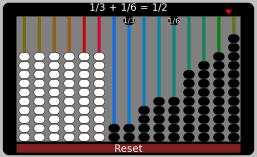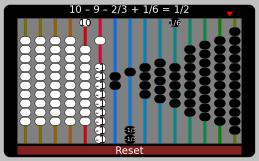Activities/Abacus/Worksheet: Difference between revisions
Tonyforster (talk | contribs) |
Tonyforster (talk | contribs) |
||
| Line 26: | Line 26: | ||
If using just one string, only some of the strings of beads can be used to make 1/2. Which ones? Why? | If using just one string, only some of the strings of beads can be used to make 1/2. Which ones? Why? | ||
To show that the solutions which use more than one string are correct, use the Lowest Common Denominator (LCM) method, for example for the case of 1/3 +1/6 = 1/2 | |||
1/3 + 1/6 = | |||
2/6 + 1/6 = | |||
(2+1)/6 = | |||
3/6 = | |||
1/2 | |||
How do you know if you have found all the solutions? | How do you know if you have found all the solutions? | ||
Revision as of 20:38, 5 April 2011
Fractions
The Fraction abacus
select the Fraction abacus.
Slide one of the 1/2 beads to represent 1/2
Another way to represent 1/2 is to slide half of another string of fraction beads, for example slide 2 of the 1/4 beads. That is (2 x 1)/4 = 2/4 = 1/2
How many ways can you make 1/2, remember you can use 2 strings eg. 1/3 + 1/6 = 1/2
If using just one string, only some of the strings of beads can be used to make 1/2. Which ones? Why?
To show that the solutions which use more than one string are correct, use the Lowest Common Denominator (LCM) method, for example for the case of 1/3 +1/6 = 1/2
1/3 + 1/6 = 2/6 + 1/6 = (2+1)/6 = 3/6 = 1/2
How do you know if you have found all the solutions?
Find all the ways to make 1/3 and 2/3
The Caacupé abacus
It can represent negative whole numbers and fractions. 1/2 can be represented as 10 - 9 - 2/3 + 1/6
How many different ways can you represent 1/2 , 1/3, 2/3
How do you know when you have found them all?
see the answersheet
